FAST FACTS: Burmese Pythons
Fast Facts About Burmese Pythons:
Type: Reptile
Diet: Carnivore
Average lifespan in the wild: 20 to 25 years
Size: 16 to 23 ft (5 to 7 m)
Weight: Up to 200 lbs (90 kg)
Did you know? "Baby," an ironically named Burmese python living at the Serpent Safari Park in Illinois, is 27 feet (8.23 meters) long and holds the record as the world's heaviest living snake at 403 pounds (183 kilograms).
Protection status: Threatened
Burmese pythons, with their beautifully patterned skin, rapid growth rate, and generally docile disposition, may be best known as the large snake of choice among reptile owners. Unfortunately these potentially huge constrictors are often poorly cared for and are frequently released into the wild. Attacks on handlers, sometimes deadly, are not uncommon.
Native to the jungles and grassy marshes of Southeast Asia, Burmese pythons are among the largest snakes on Earth. They are capable of reaching 23 feet (7 meters) or more in length and weighing up to 200 pounds (90 kilograms) with a girth as big as a telephone pole. When young, they will spend much of their time in the trees. However, as they mature and their size and weight make tree climbing unwieldy, they transition to mainly ground-dwelling. They are also excellent swimmers, and can stay submerged for up to 30 minutes before surfacing for air.
Burmese pythons are carnivores, surviving primarily on small mammals and birds. They have poor eyesight, and stalk prey using chemical receptors in their tongues and heat-sensors along the jaws. They kill by constriction, grasping a victim with their sharp teeth, coiling their bodies around the animal, and squeezing until it suffocates. They have stretchy ligaments in their jaws that allow them to swallow all their food whole.
Burmese pythons are solitary animals and are generally only seen together during spring mating. Females lay clutches of up to 100 eggs, which they incubate for two to three months. To keep their eggs warm, they continually contract, or shiver, their muscles.
Habitat depletion, continued demand for Burmese pythons in the pet trade, and hunting for their skins and flesh have landed these graceful giants on the threatened species list.
Source: National Geographic



